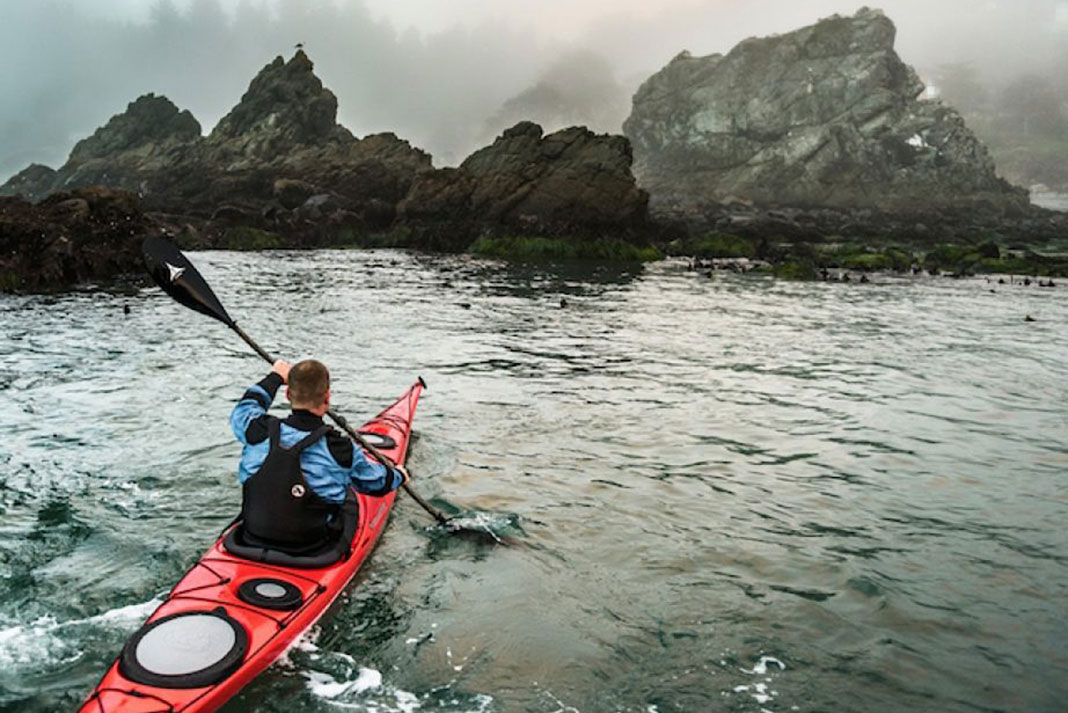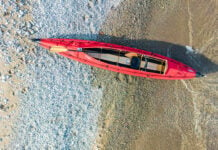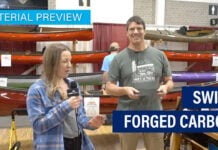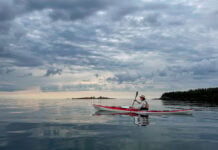The new Tempest 170 from Wilderness Systems is the brainchild of Steve Sherre of Alder Creek Canoe and Kayak in Oregon, shaper/designer Bob McDonough and the Wilderness Systems design team. What they’ve created is an appealing combination of “Brit boat” design with the high volume and plush outfitting of the North American tradition. You could call it a “Romany for the West Coast.”
Wilderness Systems Tempest 170 Specs
Length: 17’ 6”
Width: 22”
Depth: 14”
Cockpit: 32” × 14.5”
Weight: 50 lbs
Max Capacity: 110 lbs
MSRP:
$3,199 USD / $4,249 CAD (Kevlar)
$2,699 USD / $3,499 CAD (Fibreglass)
$1,399 USD (Polyethylene)
The Tempest 170 has the best of both worlds
British performance
The NDK Romany series, designed by U.K. expedition paddler Nigel Dennis, is a line of classic Brit boats with a distinctive Greenland-inspired hard-chine hull and fairly low volume. The result—a sporty and very seaworthy kayak with a good blend of tracking and manoeuvrability—is very popular in the U.K. and on the East Coast of North America.
The classic Brit traits include: no rudder (although a skeg is optional), three fibreglass bulkheads sealed with rubber hatches, low windage, a snug fit and good performance. The Brit boats have been designed for the U.K.’s typically rough seas and the skilled paddlers who venture out in them. The downside is often poor comfort, sometimes less than stellar workmanship and heavy weight.
North American comfort
The kayaks that have evolved in the Pacific Northwest tend to sport novice-friendly rudders and have much higher volume. They are Cadillacs of the sea—great for comfort and long-distance tripping in the sheltered Inside Passage—but not necessarily good for performance. These kayaks have two hatches with a variety of often leaky closure systems and luxurious seats that aspire to being little aquatic armchairs.
The Wilderness Systems Tempest 170 combines the best of both worlds. It has the look of a Brit boat, but pumped up and pimped out. The hard-chine hull shape is extremely reminiscent of the Romany. In true Brit style, the hatch covers are tight-sealing rubber and the three bulkheads are moulded fibreglass.
The Tempest 170 has room to spare
Where the Tempest radically departs from its Old World roots is the realm of comfort. The hull is considerably deeper than a Brit boat. At the expense of increased windage, there is a lot of volume, ample cargo space for multi-day trips and no lack of legroom.
The most notable feature is the Phase3 Outfitting, a high-performance seat and thigh-brace system derived from the “FAT 3.0” outfitting that Wilderness Systems’ sister company, WaveSport, puts in its whitewater boats. The foam-padded seat is adjustable with a tilting leg support, backband and very comfortable, adjustable hip pads. Wilderness Systems is to be congratulated for creating the most Mac Daddy piece of furniture ever to grace a sea kayak. Our only complaint is that when you tilt the boat, there is some lateral flex and creaking in the seat’s plastic shell that you don’t get in other boats whose seats are made of more rigid materials or glued directly to the hull. Glued foam inserts can easily solve this.
Rounding out the fit are contoured, padded thigh braces that can be easily unscrewed and moved to match different body types. Overall, the Phase3 system provides a snug, performance fit that was previously only available with custom outfitting.
Mix play and performance with the Tempest
The Tempest 170 is a nimble cruiser capable of holding its own at a touring pace. With a 22” beam, it’s a half inch wider than its British cousins. Intermediate and advanced paddlers will find it has plenty of initial stability and tracks will on an even keel. The Tempest tends to be a bit unsteady in transition from edge to edge, but once on edge its stable and cranks nice tight turns.
The Wilderness Systems Tempest 170 has a performance hull with outfitting to match and a volume that’s hard to find in a boat of its type. It’s a great choice for intermediate to advanced paddlers looking for a playful British design that performs well in surf and rough water but also has a comfortable cockpit and expedition-capacity volume. Available in polyethylene, fibreglass or Kevlar, as well as a smaller 16’6” version.









